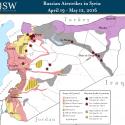 |
 |
Russian Airstrikes in Syria: April 19 - May 12, 2016
May 13, 2016 - Genevieve Casagrande


Pro-regime forces supported by Russian airpower are continuing operations to encircle and besiege the Syrian opposition in Aleppo City following the expiration of a series of temporary ceasefires on May 12. Russian air operations in Aleppo from April 19 – May 12 demonstrate Russia’s continued prioritization of support to its client regime in Damascus. Russia has nonetheless continued to present itself as a constructive international arbiter to the Syrian conflict through a series of Russian- and U.S.-brokered partial ceasefire deals from May 4 – 11. Russia maintains a robust military presence in Syria and has continued its military campaign, following Russian President Vladimir Putin’s announcement of a partial withdrawal on March 14 and subsequent reports of continued Russian drawdown. Russia has rather begun to reshape its military deployment in Syria, withdrawing certain airframes from the Bassel al Assad airbase while deploying additional rotary wing aircraft, developing new basing near Palmyra, and maintaining “several thousand” Russian ground forces in the country. “Dozens” of Russia’s fixed wing aircraft reportedly remain at its airbase in Latakia and continue air operations against both the armed opposition and ISIS across Syria.
Russian air operations seek to preserve strategic regime-held terrain and Russia’s military basing in Syria. Russian airstrikes escalated against ISIS’s positions throughout Syria to include areas in Homs, Deir ez-Zour, and Raqqa, following ISIS’s resumption of large-scale operations against pro-regime forces in central Homs on May 3. These operations have been primarily focused on seizing strategic gas fields that serve as the regime’s primary source of natural gas for areas in western Syria. ISIS seized the Sha’er Gas Field from pro-regime forces on May 5 and subsequently severed the primary regime ground line of communication (GLOC) between Homs City and Palmyra on May 10, inhibiting the ability of pro-regime forces to redeploy to critical frontlines with ISIS in the area. Russian airstrikes responded to this threat, targeting ISIS’s positions in the Sha’er Gas Field and the nearby Mahr Gas Field. ISIS’s operations also pose a threat to Russian’s own military contingent in central Homs, which includes its newest military base near Palmyra as well as its reported rotary wing deployment in the regime’s T4 and Shayrat airbases. Western journalists brought to Palmyra by Russia as well as local activists reported that Russia established a new military base in Palmyra, following the regime’s recapture of the ancient city on March 27. The base reportedly facilitates Russian demining operations and is guarded by air defense systems and armored vehicles. Russian advisors are likely deployed near active frontlines, as indicated by the death of a Russian soldier in Homs Province on May 11 in addition to ISIS’s claims to kill at least five Russian Spetnaz personnel during regime operations to seize Palmyra in late March.
Russia is using the series of strained and intermittent ceasefires in Aleppo to reset its operations against opposition forces in the area. Russian air operations have continued in Aleppo, which was once the primary focus of Russia’s air campaign, albeit at decreased and sporadic rates. The Syrian regime has in turn barraged Aleppo with intense airstrikes beginning on April 22, making Russian airstrikes in the area difficult to discern. Regime and Russian strikes in Aleppo from April 22 – 30 killed and injured over 145, including a strike on a Doctors Without Borders hospital that killed over 60. ISW was not able to assess any Russian strikes with low confidence in Aleppo from April 30 – May 4, but airstrikes resumed targeting the Syrian opposition in the city on May 5. Russia has also reportedly begun to deploy additional assets to Aleppo, including ground forces to the Efrin Canton in northwestern Aleppo to support the Syrian Kurdish YPG and artillery units north of Aleppo City. The opposition meanwhile launched major operations against regime forces south of Aleppo City, securing the town of Al Eis on April 1 as well as Khan Touman on May 5 - 6. Delayed and limited Russian airpower was unable to reverse gains made during the opposition’s offensive against the town of Khan Touman south of Aleppo led by al-Qaeda’s Syrian affiliate Jabhat al Nusra and Salafi-Jihadist group Ahrar al Sham. The offensive was timed alongside a Russian-organized concert in the ancient ruins of Palmyra, which required a significant number of Russian attack helicopters and armored vehicles to secure the guests in attendance. Iranian forces, without the support of major Russian airstrikes, suffered heavy losses in the Khan Touman offensive. Pro-regime forces, however, resumed operations to encircle opposition forces in Aleppo City through its northern industrial outskirts on May 12 as the as the temporary 48-hour ceasefire expired. Opposition forces reportedly prevented pro-regime advances in the area despite Russian airstrikes.
The following graphic depicts ISW's assessment of Russian airstrike locations based on reports from local Syrian activist networks, Syrian state-run media, and statements by Russian and Western officials. This map represents locations targeted by Russia's air campaign, rather than the number of individual strikes or sorties.
High-Confidence reporting. ISW places high confidence in reports corroborated both by official government statements reported through credible channels and documentation from rebel factions or activist networks on the ground in Syria deemed to be credible.
Low-Confidence reporting. ISW places low confidence in secondary sources that have not been confirmed or sources deemed likely to contain disinformation.